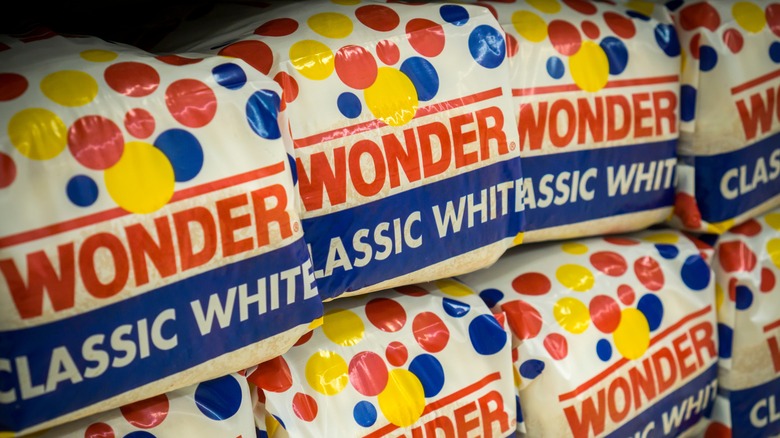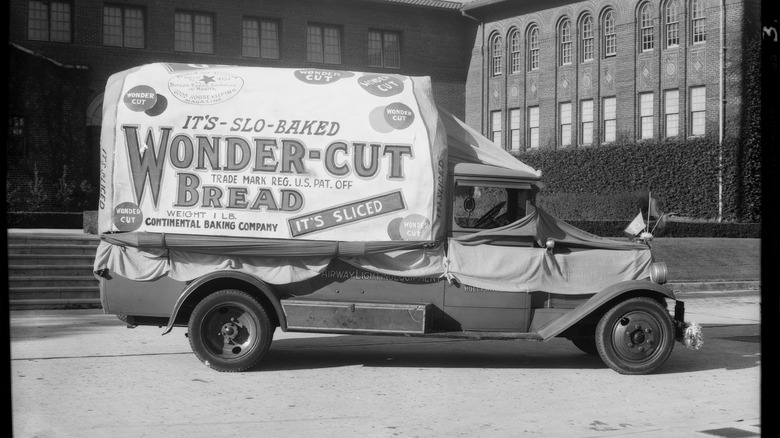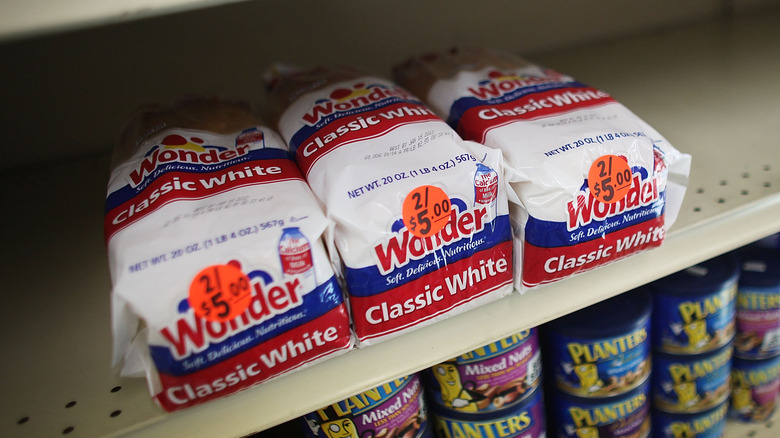The Meteoric Rise, Fall, And Return Of Wonder Bread
It's the most famous bread in America, for better and for worse. Wonder Bread is iconic and controversial, beloved and hated. The brand once stood atop the bread world, but in today's era of homemade sourdough bakers and heightened health consciousness, it has been held up by some as the epitome of an over-industrialized food system, unnatural and even suspicious in nature. Wonder Bread has certainly had a turbulent history, one that almost ended a decade ago when the brand briefly disappeared from stores.
It all began one morning in 1921, when people in Indianapolis opened the local newspaper to find a bizarre advertisement. It read "Wonder" in large type, but nowhere did it mention what the product being advertised actually was. In the coming weeks, more mysterious ads popped up in the paper, promising wonder, but revealing nothing else. Finally, on May 21st of that year, the Taggart Baking Company unveiled their latest product: a fluffy white loaf dubbed Wonder Bread.
The public reception was sensational. In the years following WWI, white bread had been swiftly gaining popularity in the United States. The perfectly shaped loaves, much softer than other breads, delighted people. It was an era before expiration date labels, when the public couldn't rely on food being fresh, and a bread so soft to the touch screamed quality. Today, the fact that Wonder Bread stays so soft for so long is regarded as unnatural, but back then, people viewed processed foods with a lot more, well, wonder.
Putting the wonder in Wonder Bread
The mind behind Wonder Bread's mystery ad campaign was the Taggart Baking Company vice president, Elmer Cline. As successful as the campaign was, this was not even Cline's greatest contribution to the brand. He also named it. A year before Wonder Bread's release, Cline was watching the International Balloon Race at the Indianapolis Speedway, and as the colorful balloons floated through the sky, his mind was struck by one word: wonder. Cline decided it would be the perfect name for Taggart's new product, and the event also inspired the balloon imagery on Wonder Bread's iconic packaging.
Americans in the interwar years regarded the rise of industrialism with hope. The uniformity achieved by mass-producing foods was seen as an indication of quality. Wonder Bread also came in 1.5-pound loaves while the standard for other brands was only one pound, making it emblematic of the prosperity gained through manufacturing.
Perhaps the greatest leap for Wonder Bread came in 1930, when it began selling sliced bread. Contrary to popular belief, Wonder Bread didn't invent sliced bread. The first bread-slicing machine had been unveiled two years earlier by the Chillicothe Baking Company, but Wonder Bread was one of the first mainstream brands to offer it. This furthered Wonder Bread's image as a brand for a new American era. In fact, Wonder Bread was even featured at the 1939 World's Fair Food Zone, an exhibit that promised to show viewers visions of the foods of the future.
The near extinction of Wonder Bread
In 1925, Taggart was acquired by the Continental Baking Company, which assumed the production of Wonder Bread, as well as another line of Taggart products: Hostess sweets. Under Continental ownership, Wonder Bread and Hostess became nationwide brands. Business boomed after WWII, with Wonder Bread becoming a staple for the baby boomer generation. With the rise of television, Continental ran relentless advertisements, making its products a household name. But over the years, people began to raise concerns about the high levels of sugar in Wonder Bread, and the Federal Trade Commission even accused Continental of misleading advertising by promoting Wonder Bread as healthy.
The public view of Wonder Bread began to sour near the end of the 20th century, when public concern over processed foods was on the rise, and a new emphasis was placed on health-conscious eating. Wonder Bread is one of the least healthy store-bought breads, and whole wheat and artisan breads began to push it out of favor.
This decline eventually forced Hostess to declare bankruptcy in 2012. Production of Wonder Bread halted, and many feared it would never return. However, in 2013, Flowers Foods, owner of numerous bread brands such as Nature's Own and Dave's Killer Bread, rode in to save Wonder Bread, buying it for $360 million. It's back in stores again now, but it has never been able to recapture the same sense of wonder it once had.


